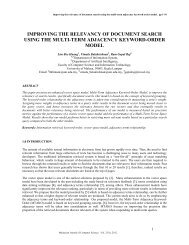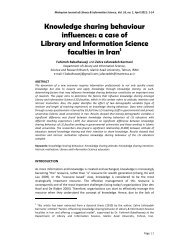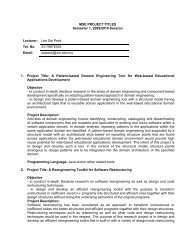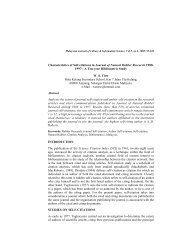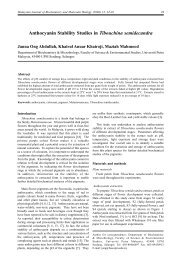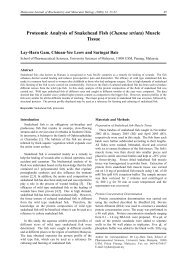Design and Implementation of a Private and Public Key Crypto Processor for Next-Generation IT Security Applications pp. 29 - 45In RSA, each user has a pair of keys, i.e. public key (E, M) and private key (D, M). M is the modulus, E is the publicexponent and D is the private exponent. RSA key length refers to the bit length of the modulus. These keys aregenerated using the algorithm as shown in Fig. 10. p and q must be kept secret or deleted. (gcd stands for greatestcommon divisor. D is the multiplicative inverse of E modulo M.)1. Generate 2 primes, p and q randomly.2. Calculate M = p.q, and Φ(M) = (p-1).(q-1).3. Generate E that fulfills both the conditions 1< E < Φ(M), and gcd (Φ(M) , E) = 1.4. Calculate D = E -1 mod Φ(M).Fig. 10: RSA key pair generation algorithm4.3 ECC Processor for Public Key CryptographyN. Koblitz and V. Miller first suggested Elliptic Curve Cryptography (ECC) in 1985 [1]. The main strength of ECCrests on the concept of solving discrete logarithm problem (DLP) over the points on an elliptic curve. This providesfor higher strength-per-bit than any other public key cryptosystem, implying that significantly smaller parameterscan be used in ECC as compared to other competitive systems, but with equivalent levels of security. For example,the security level of a 160-bit ECC key is equivalent to 1024-bit RSA [11]. The benefits of having smaller key sizesinclude faster computations, and reductions in processing power, storage space and bandwidth. This makes ECCideal for resource-constrained environments such as pagers, PDAs, cellular phones and smart cards.Fig. 11(a) shows the arithmetic hierarchy of ECC, which indicates that ECC essentially requires the application oftwo types of mathematics: elliptic curve arithmetic and the underlying finite field arithmetic. ECC-based securityprotocols such as ECDSA (Elliptive Curve Digital Signature Algorithm), ECDH, and ECES are performed usingECC arithmetic functions at the top level of the ECC arithmetic hierarchy. An example is shown in Fig. 11(b),where ECC point multiplication and point add is performed in ECDSA security scheme. Elliptic curve arithmeticdefines the algorithms to perform these point multiplying, point adding, point doubling, and othercontrol/conversion functions. The finite field arithmetic provides basic finite field operations include field inversion,field addition, field multiplication and field squaring.1.0 ECDSA SIGNATURE VERIFICATIONALGORITHMInput: G (Finite point in domain parameter),Q (public key of entity A),m (message),(r, s) Signature on message of entity A.Output: Accept or reject signature from A.1. Verify r, s are integers in the interval [1, n-1].2. Perform crypto hashing, e = SHA-1 (m).3. Compute w = s -1 mod n4. Compute u 1 = ew mod nand u 2 = rw mod n.5. Perform ECC point multiply & point add: X(x 2, y 2) =u 1G + u 2Q.6. If X = O, then reject the signature. Otherwise, compute v= x 2 mod n.7. Accept the signature if and only if v = r.Fig. 11(a): The arithmetic hierarchy of ECCFig. 11(b) ECDSAsSignature verificationThe current version of the proposed cryptosystem applies the ECC domain parameters as follows:1. Type of underlying finite field: Binary field in GF(2 163 ).2. Field representation: Polynomial basis representation.3. Type of elliptic curve: Over F m 2 , Koblitz Curve sect163k1 taken from [8].36Malaysian Journal of Computer Science, Vol. 19(1), 2006
Design and Implementation of a Private and Public Key Crypto Processor for Next-Generation IT Security Applications pp. 29 - 454. Elliptic curve point representation: Point Multiplication in Projective Coordinates, and Point Addition inAffine Coordinates, supported by trinomial & pentonomial as recommended by IEEE, NIST.The elliptic curve point multiplication is the core operation. In ECC, the fundamental crypto operation is this pointmultiplication, i.e. a point P a is (point) added to itself k times, over an elliptive curve.Q = kP = P + P + … + P (k times) ……(1)An elliptic curve over the finite field GF(p) is defined as the set of points (x, y) which satisfy the operation:y 2 = x 3 + ax + b……(2)where x, y, a and b are elements of the field, and 4a 3 + 27b 2 ≠ 0. To encrypt, the data is represented as a point on thechosen curve over the finite field.This work implements binary field GF(2 163 ), or so called binary finite field, because of its high efficiencyachievable in hardware implementation. Due to the reason that normal basis representation is not the best choice foran elliptic curve processor with flexible finite field support, the polynomial basis representations have been chosenas the basis of binary field arithmetic in this work. The field elements are represented as polynomial basis withcoefficient 0 or 1. The design is adapted towards supporting both trinomial and pentanomial as recommended byIEEE and NIST. The projective coordinate system is applied instead of affine coordinate system, and this is toeliminate field inversion in point addition and point doubling. Field inversion is the most complex and expensiveoperations in terms of processing time and hardware resource. Montgomery point multiplication algorithm inprojective coordinate is chosen in this work because it prevents information leakage in the form of power signaturedifferences and offers comparatively better performance. Fig. 12 gives a summary of Montgomery PointMultiplication in projective coordination.Algorithm-3: Montgomery Point Multiplicationl 1Input: k = ∑ − ik ⋅ 2 , ∈[0,1]i=0 iki(multiplier)P(x, y) – a random point on an elliptic curve (multiplicand).Output: Q = kP = (x Q, y Q)1. (X 1, Z 1, X 2, Z 2) = Conv_affine_projective(x, y, b)2. for i = l – 2 down to 0 do2.1 if k i = 1 then(X 1, Z 1) = M_add(X 1, Z 1, X 2, Z 2, x)(X 2, Z 2) = M_double(X 2, Z 2, b)else(X 2, Z 2) = M_add(X 2, Z 2, X 1, Z 1, x)(X 1, Z 1) = M_double (X 1, Z 1, b)end for3. (x Q, y Q) = Conv_projective_affine(X 1, Z 1, X 2, Z 2, x, y)Fig. 12: Montgomery Point Multiplication (Projective Coordinate Version)Fig. 13 shows the architecture of the control unit and the datapath module of the ECP core. The control unit utilizesa micro sequencer and an iteration counter. Meanwhile, the datapath module performs basic finite field arithmeticoperations such as field addition, field multiplication and field squaring. It comprised a register file and anarithmetic unit incorporates a finite field multiplier, a parallel squarer and accumulator and a zero test circuit. For amore detailed description of the algorithm and design of the ECP, please refer to [12] and [13].To strike a balance between parallel and bit-serial multiplication, this work implements Least Significant Digit First(LSD-First) multiplication to perform finite field multiplication in the ECP design due to its shorter critical pathdelays. Besides, parallel squaring with fixed irreducible polynomial support together with Itoh-Tsuji inversion areapplied in this design for the purpose of simple and efficient hardware implementation of field inversion. The ECPdesign is described completely in parameterized VHDL code, such that the core is reconfigurable and reusable. Inthis parameterizable design, the processor can be configured to support any field size and polynomial, asrecommend by NIST and Certicom [3]. For working environment with memory, bandwidth, or power dissipationconstraint, user can vary the degree of parallelism in the multiplier to achieve desired performance-cost trade-off.Malaysian Journal of Computer Science, Vol. 19(1), 200637



